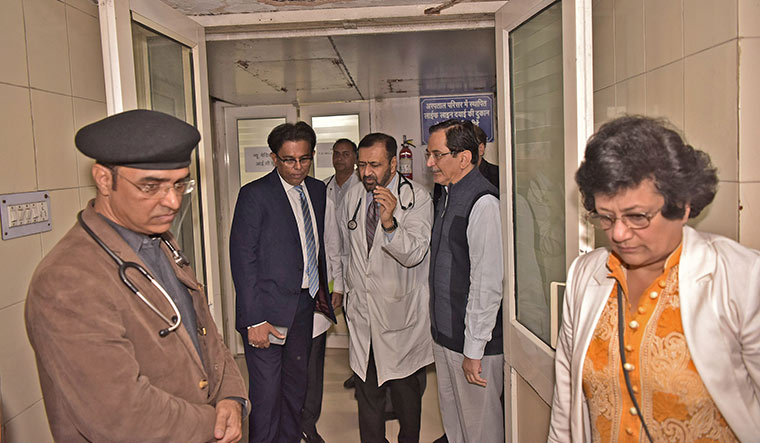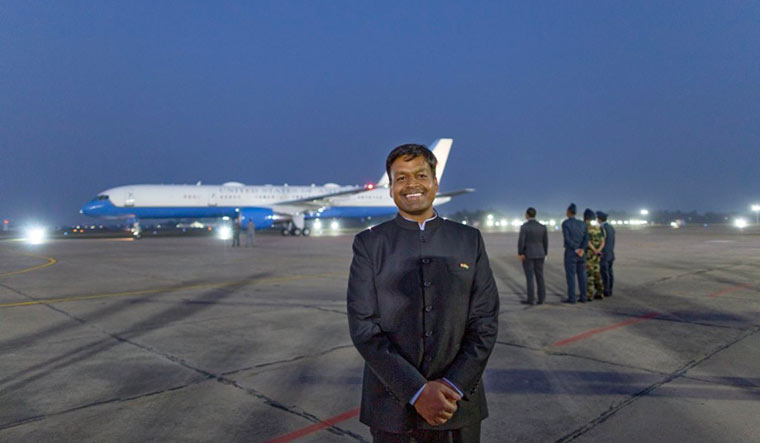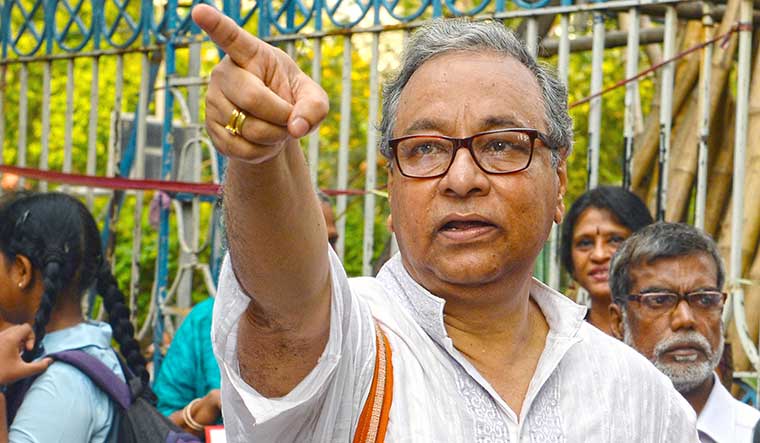Just over a month into his new job, Prabhu Narain Singh, the 40-year-old district magistrate of Agra, had an enviable assignment: to make arrangements for the visit of US President Donald Trump and his wife, Melania, to the Taj Mahal. The visit went without a hitch, earning him praise. Little did he realise that another, much bigger challenge was coming his way.
On February 25, a day after the Trump visit, Sumit Kapoor, a local businessman, returned to Agra after attending a trade expo in Italy. On March 2, he tested positive for Covid-19 and was sent to Safdarjung Hospital in Delhi along with six members of his family. His brother-in-law Rohit Dutta, who had travelled with Kapoor to Italy, was the first positive case in Delhi. The same day, a group of 19 tourists reached Agra from Rajasthan. One of them tested positive and was quarantined in Rajasthan. A day later, 15 of them tested positive in Delhi. As the infection started spreading across the country, Cabinet Secretary Rajiv Gauba instructed chief secretaries of all states that district collectors should hold coordination meetings and set up teams for cluster management of the pandemic at district, block and village levels. The intervention proved to be crucial.
“Agra receives a large number of tourists and we told hotels to reserve one floor for foreign tourists so that if someone tested positive, it can be contained there,” said Prabhu Narain Singh. “This helped us in limiting the contact of the Italians who were carrying a high viral load. We also quarantined 159 staffers of the five-star hotel where the Italians stayed.”
The next challenge: members from 42 families in the city had gone to Italy for the expo. Two people (including Kapoor) passed it on to relatives. “It was the first cluster in the country. We were new at that time and were learning as we started contact tracing. So we were able to contain it without lockdown,” said Prabhu Narain Singh.
The third wave in Agra came from people who had attended the Tablighi Jamaat meeting in Delhi. As the city successfully managed the challenge, the Centre announced on April 12 that the Agra model of cluster containment should be replicated across the country. The city, however, was hit by a fourth wave. Some of the patients who went to local hospitals infected more people. As Agra is a medical hub for the neighbouring areas, the infection spread to medical workers and patients, overshadowing the city’s early success.
In neighbouring Rajasthan, the biggest challenge was in two cities, Jaipur and Bhilwara. Additional Chief Secretary Rohit Kumar Singh said the state adopted ruthless containment—a term he coined—to tackle the pandemic. “You have to be polite, but firm. And you should address daily needs of the people so that they do not become your adversaries,” he said. He also stressed on the importance of tailoring strategies to suit local requirements. “Dealing with Bhilwara is different from dealing with the walled city in Jaipur. In Bhilwara, doctors were infected. They became super spreaders. Jaipur was different as there were individual cases. So we had to adopt a slightly different approach.”
Thousands of kilometres away in Kerala’s Kasargod district, the state government sent senior IAS officer Alkesh Kumar Sharma, managing director of Kochi Metro, to oversee the fightback after the local administration found it difficult to manage the spurt in cases. “When I was assigned the district, the lockdown was already on,” said Sharma. “But that was the first step. We went for cluster containment and then active containment where cases were coming up. The key was ensuring home delivery of essential goods. The next task was to find out primary and secondary contacts of infected people and also high-risk cases.”
The massive fight being put up in 736 districts across the country is marked by the proactive role of civil servants, especially district collectors, also called district magistrates and deputy commissioners in different states. The fightback seems to be a part of their collective institutional memory as the civil services have been at the forefront of handling epidemics from the colonial times. It has brought the shine back to India’s famous steel frame. As they belong to the same service, it is easy for officers to share notes and seek advice from their successful counterparts. “Six of my batchmates are health secretaries in different states. IAS officers are better at coordination, and this is working as we go along,” said Rohit Kumar Singh.
Jammu and Kashmir, which is struggling with a fragile political and security situation, too, has witnessed an exemplary response to the pandemic. Shahid Choudhary, deputy commissioner, Srinagar, and Rohit Kansal, principal secretary and government spokesperson, are among the bureaucrats leading the response. By providing regular updates on social media about the pandemic, Kansal has emerged as a vital link between the government and the people.
In Haryana’s Nuh district, which is the epicentre of the pandemic in the state, Deputy Commissioner Pankaj said he enlisted the help of local imams and community leaders to get the message across in Muslim-dominated areas, after the return of people who attended the Tablighi Jamaat meeting.
In Gujarat, too, IAS officers are leading the fightback against the pandemic in the two most affected cities of Ahmedabad and Surat. Municipal Commissioner Vijay Nehra turned Ahmedabad’s walled city into a fortress once again by swiftly implementing cluster containment after the return of Tablighi Jamaat attendees from Delhi. He launched intensified testing among vegetable vendors; 200 tested positive. Health cards were issued to vendors and people are advised to buy vegetables only from those with valid cards. Nehra, meanwhile, has gone into self-isolation on May 5, after he came into contact with two persons who tested positive subsequently. In Surat, Municipal Commissioner Banchhanidhi Pani was swift in dealing with a similar situation in the Rander area.
“In a crisis, there is no substitute to civil servants on the ground. When asked to deliver, they have delivered. The government is always dependent on civil servants,” said retired IAS officer Anil Swarup, author of Not Just a Civil Servant. He said the response to Covid-19 had demonstrated that the steel frame continued to be the same.
One major challenge for the officers while tackling the pandemic has been providing food for the poor and the migrants affected by the lockdown. “Initially, we arranged community kitchens through private help, but soon shifted to providing dry rations as no proper social distancing could be maintained. Though there may be some pilferage or hoarding, it is much more effective,” said Girish Dayalan, deputy commissioner, Mohali, Punjab.
One of the things that worked in favour of district collectors is that most of them are young. “We are able to run around and that is why we have been on the job. At the district level, even the chief medical officer is old and, therefore, in danger,” said Prabhu Narain Singh. When the government wanted a ground report after the country went into lockdown, the department of administrative reforms and public grievance conducted a survey among district collectors. They flagged the lack of preparedness and health infrastructure at the grassroots level and recommended extension of the lockdown. The government has gone by their advice.
Some of the bureaucrats even went beyond the Indian Council of Medical Research’s initial protocol of testing only symptomatic patients. “The ICMR asked to test only those who were symptomatic, but we went beyond that,” said Sharma, recounting his experience in Kasargod. Family members of those with symptoms were traced and quarantined. Rohit Kumar Singh adopted the same strategy in Rajasthan. “The ICMR offers the guiding principle, but you have to see the reality,” he said. “The ICMR suggested contact tracing of confirmed contacts of Covid-19 patients. Normally, it would mean family members, drivers and domestic helps. But you have to see the local situation where people pray together or sit together in the alleys. So that definition does not apply. We tested aggressively in Rajasthan.” Similar views were expressed by officials in Mohali and Agra. “We should be not afraid of the rising numbers as we can then contain them,” said Dayalan. “Not knowing positive cases will not help. In that sense, we did break from the ICMR protocol by going in for aggressive testing.” Such out-of-the-box thinking has gone a long way in tackling the pandemic.
“There has been no substitute in independent India to the evolved collector. Given a chance, these chaps will come up with innovations,” said retired IAS officer Jawhar Sircar, who was CEO of Prasar Bharati. Often derided as status-quoist and slow-moving, the bureaucracy earned praise this time from Vice President M. Venkaiah Naidu and Prime Minister Narendra Modi. Under Modi, IAS officers have been feeling the heat, with the government pushing for reforms and trying to reduce the overwhelming reliance on IAS officers in governance. The Modi government, for instance, has brought in a lot more non-IAS officers at the joint secretary level. A bigger blow was the appointment of 10 domain experts in 2018 as joint secretaries under the lateral entry scheme based on the recommendations of the Niti Aayog. Former Niti Aayog vice chairman Arvind Panagariya recently told THE WEEK that India needed a lot more outsiders with specialised skills. “The system will always need generalists, but the current balance is not right,” he said.
IAS officers, however, feel that it is important to have generalists who are better at management. “An expert need not be a good administrator. For example, a doctor may not be good at clinical management. That is why a health secretary need not be a doctor,” said Rohit Kumar Singh. Sircar said the best brains from the IITs and the IIMs were joining the civil services. “I am not against inducting professionals through lateral entry, but they should be given permanent status so that they have a stake in the system,” he said.
While the Modi government has been pushing for reforms, it has also been engaging actively with the bureaucracy after having realised that district collectors are crucial to the success of the government’s pet initiatives. Modi has entrusted his key bureaucrats with the responsibility of handling the ongoing health emergency. Gauba regularly holds meetings with state chief secretaries, Health Secretary Preeti Sudan has been instrumental in strategising government response, while joint secretary level officers Lav Agarwal and Punya Salila Srivastava have become the face of the government’s information and publicity outreach.
Most of the officers have been working above and beyond the call of duty, even ignoring personal and family emergencies. Nikunja Dhal, health secretary of Odisha, and C.R. Kharsan, collector of Gujarat’s Valsad district, reported for duty a day after suffering a bereavement. Srijana Gummalla, commissioner of the Greater Visakhapatnam Municipal Corporation, returned to office three weeks after giving birth. Punjab Special Chief Secretary K.B.S. Sidhu spoke about tehsildars and junior officers who came forward to cremate bodies of Covid-19 victims after their families refused to do so.
What has given a defining edge to the fight against Covid-19 has been the skilful use of technology. Many IAS officers have helped develop apps to map the location of patients and the availability of goods and also to address grievances. Munish Moudgil, special officer in charge of Karnataka’s Covid-19 war room, helped develop two apps—Quarantine Watch and Corona Watch—which gave the state an early edge by reducing the need for manual surveillance of primary and secondary contacts of confirmed cases.
Tamil Nadu’s Tiruppur district, which is a red zone, is a hub for making personal protective equipment for health workers. It is also home to 1.3 lakh migrant workers. “We have mapped them, created a database and we are soon going to enumerate their bank accounts,” said District Collector K. Vijayakarthikeyan.
“The young DMs are intelligent, they need an independent hand to drive innovation,” said Sircar. “It is from the joint secretary level that there should be reforms and change of attitude, be it weeding out the corrupt, or adopting paper-free decision-making for faster delivery.” Sircar said there was a perception that IAS officers did not do any work, but the fight against Covid-19 had dispelled those doubts. “I do not see any dramatic change happening in the civil services,” he said.
As the iconic character Sir Humphrey Appleby from the British television series Yes Minister and Yes Prime Minister says, “Real reductions in the size of the service? It’d be the end of civilisation as we know it.”
WITH TARIQ BHAT, LAKSHMI SUBRAMANIAN, NANDINI OZA AND AAYUSH GOEL





